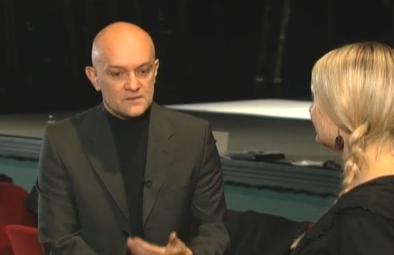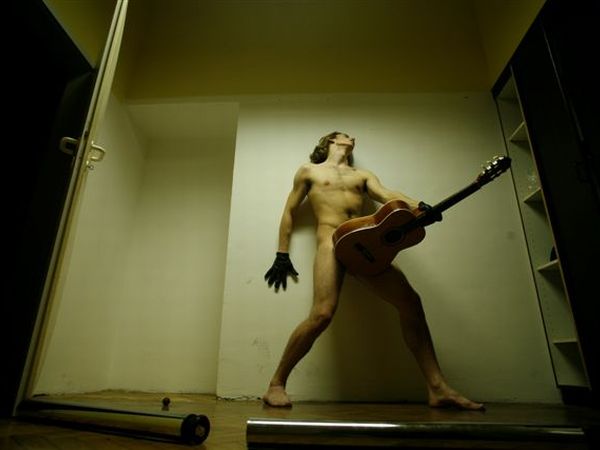

In our institution we provide more than 600 events a year, attended by more than 40,000 people. In Slovenia we were the first to establish a professional contemporary dance group with its own home stage. We were the first dance group and also non-governmental organisation to acquire a public structure to manage. We had already achieved international recognition 25 years ago, and have been constantly building on it. We have collaborated with world-famous co-producers and choreographers/directors, and we are also the first ones to successfully transfer dance to the medium of film. We are an exception, since we have succeeded in being able to stage productions continuously and they have a long lifespan. Equally, we have made some major achievements in long-term cooperation in the area of cultural and arts education for all age groups, and in training for teachers.

You come from the mining area of Trbovlje, and hence your name, En-Knap (miner). How did that environment mark you?
In 1993 I gathered together a team of five dancers from all over the world and founded the group En-Knap. This team first hit the stage in Belgium with the performance Razširi krila, Slon nerodni (Spread your Wings, Clumsy Elephant). It was dedicated to Trbovlje, where I returned unexpectedly in 1990 after years of travelling all over Europe. At that time I first sensed the force and power of my birthplace, and Trbovlje then became a powerful resource for my subsequent stage and film work. In the first shows I sought sources of inspiration that marked my expression in movement, and methods of being able to transfer to the group my own expression, which I had discovered in the solo performance Kako sem ujel Sokola (How I Caught a Falcon), and which later opened the door for me internationally. I can say that without the influence that Trbovlje had on my creative work, the EN-KNAP Institute and the dance group we know today probably would not exist.
You were the first to present Slovenian contemporary dance to European and global audiences.
In the eighties I left Yugoslavia. I wanted to explore what was on offer behind the Iron Curtain. Soon enough I found my way to the Rotterdam Dance Academy, quickly left it, attended auditions and took part in small and large projects. That period as a dancer lasted up until the performance of Achterland with the Rosas group. Then I returned to Trbovlje, where I dissected the knowledge I had acquired and had a reckoning with myself in the solo performance How I Captured the Hawk. At that time there was an exceptionally favourable climate abroad for all things contemporary dance, audacious, wild and rebellious, and with my artistic expression I fit well into that world.
In 2007 you founded EnKnapGroup, the first permanent dance group in Slovenia. What material did you present?
Before 2007 I had gradually started to understand that I needed to take a step forward. I founded the group on my own initiative and in this way was able to show the importance of continuous work in dance and a repertoire approach, which was a novelty in contemporary dance. My goal was for the EN-KNAP Institute, of which the international dance group EnKnapGroup is a key component, to become the cornerstone for a public dance institute of national importance. It seems to me that this succeeded in part. In its 10 years of operation, EnKnapGroup has become stabilised and is now a recognised brand, not just in Slovenia but abroad, too.
Two years later you took over management of the Španski borci Cultural Centre in Ljubljana. What was your vision?
We wanted to boost the power of contemporary dance in Slovenia and build a platform from which the dancers in EnKnapGroup, as well as other non-governmental dance productions and festivals, could continuously engage with our audiences. A permanent stage offered us precisely that – building an audience that is interested in dance and can develop together with us. Furthermore, right from the start we have been trying to attract big names from abroad and high-quality productions, which Slovenian audiences would otherwise not see. We are now in the Aerovawes network, through which as part of the events under the trademark Uvoz-Izvoz (Import-Export) and the whole Plesna Vesna dance festival we are bringing to Slovenia both acclaimed works and young, extravagant European dance productions.
Within Slovenia you also advocate for a higher level of contemporary dance: adequate infrastructure, education and so on. How successful have you been so far?
In our institution we provide more than 600 events a year, attended by more than 40,000 people. In Slovenia we were the first to establish a professional contemporary dance group with its own home stage. We were the first dance group and also non-governmental organisation to acquire a public structure to manage. We had already achieved international recognition 25 years ago, and have been constantly building on it. We have collaborated with world-famous co-producers and choreographers/directors, and we are also the first ones to successfully transfer dance to the medium of film. We are an exception, since we have succeeded in being able to stage productions continuously and they have a long lifespan. Equally, we have made some major achievements in long-term cooperation in the area of cultural and arts education for all age groups, and in training for teachers.
At the end of March this year, in the German city of Mainz, you staged the dance show Sokol! (Falcon!)
That's true. March was a very full month in terms of hosting our productions. The dance-theatre show Zasledovalci sreče (Pursuit of Happiness), created together by dancers of EnKnapGroup and Pavol Liška and Kelly Copper of Nature Theater of Oklahoma, was performed at the beginning of March at the Rotterdamse Schouwburg in the Netherlands, where it thrilled audiences. This is currently our “hottest” production, with prestigious co-producers and numerous tour dates, including in New York at the famous Under the Radar festival. In March we also appeared at the tanzmainz #2 festival in Germany with two productions. First the EnKnapGroup dancers and the musicians of the Branimir Slokar Academy ensemble, conducted by Živa Ploj Peršuh, staged my dance production Ottetto (8 nihajev za njegovo visokost) (OTTETTO(8 Swings for His Highness)). Later, Janez Janša (note: the stage name of Emil Hrvatin, and not the politician) and I performed the dance production The Falcon!, in which we face the issue of ageing in dance. The Hawk! show was also staged another time in March, at the Tanzquartier Wien in Vienna, which is one of the leading contemporary dance institutions in Europe.
The coming 2017/2018 season at the Španski borci Cultural Centre will be a jubilee year. How will you mark it?
This year we are celebrating 10 years since the founding of EnKnapGroup, which from its beginnings has grown into a mature and very multifaceted group of dancers with diverse nationalities. Next year we will celebrate the 25th anniversary of the EN-KNAP Institute. We decided to flavour the coming season with the spirit of all these celebrations, and have invited colleagues from past years to join us. The programme for the entire season will be rich, and will reach its high point in April 2018 with a week-long festival of contemporary arts where we will also be laying on a proper dance marathon.
What other shows will you be performing this year?
After the first showing in December of Pursuit of Happiness, which received a fantastic response from audiences and critics, both at home and abroad, we started working on a post-production for “brave” kids, Hellhound (Hud pesjan), in which we bring up the topic of violence and raise numerous questions, all in our own style. And in June 2017 EnKnapGroup will give the first performance on our own stage of one of the more complex projects we’ve tried to date, a double evening of the recently passed legend of postcontemporary dance, the American Trisha Brown, and the Vojvodina-Hungarian-French star Josef Nadj. The artistic director of the Trisha Brown group and Josef Nadj will work with our group on an arrangement of productions from the 1980s, Set Reset and Nadj’s first work, Canard pekinois.
Tanja Glogovčan, Sinfo
In our institution we provide more than 600 events a year, attended by more than 40,000 people. In Slovenia we were the first to establish a professional contemporary dance group with its own home stage. We were the first dance group and also non-governmental organisation to acquire a public structure to manage. We had already achieved international recognition 25 years ago, and have been constantly building on it. We have collaborated with world-famous co-producers and choreographers/directors, and we are also the first ones to successfully transfer dance to the medium of film. We are an exception, since we have succeeded in being able to stage productions continuously and they have a long lifespan. Equally, we have made some major achievements in long-term cooperation in the area of cultural and arts education for all age groups, and in training for teachers.

































































